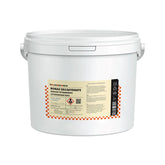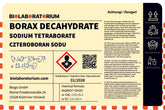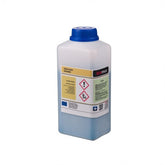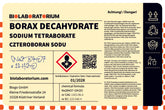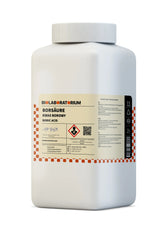Litmus – A versatile pH indicator in chemistry
Litmus is a classic pH indicator that has been used for centuries in analytical chemistry and chemistry education. This natural dye, obtained from certain lichen species, allows us to quickly and easily determine the acid-base properties of solutions. In this blog post, we want to take a closer look at litmus and its diverse applications in chemistry.
The History of Litmus
Litmus has a long tradition in chemistry. As early as the 13th century, the dye was used by Arab alchemists to test the pH value of solutions. The name 'litmus' is derived from the Dutch word 'lakmoes', which in turn goes back to the Arabic word 'lakk' for dye.
In the 17th century, litmus was then studied in more detail by the Swedish chemist Carl Wilhelm Scheele and established as a pH indicator. Scheele recognized that litmus turns red in acidic solutions and blue in basic solutions. Thus, he was one of the pioneers of acid-base chemistry.
Today, litmus remains a widely used pH indicator employed in schools, laboratories, and even in households. Its simple handling and clear color reaction make it a valuable tool in chemical analysis.
How does litmus work?
Litmus is a mixture of various natural dyes obtained from certain lichen species. These dyes, such as azolitmin, react sensitively to the pH value of a solution.
In acidic solutions with a pH value below 4.5, litmus takes on a red color. In basic solutions with a pH value above 8.3, it appears blue. In the neutral range between pH 4.5 and 8.3, litmus is violet.
These color changes are based on chemical reactions of the dyes depending on the pH value. In acidic solutions, the dyes are protonated and take on a red color. In basic solutions, they are deprotonated and appear blue.
Thus, litmus is a so-called pH indicator that allows us to quickly and easily determine the acid-base character of a solution. Through the color change, we can read whether a solution is acidic, neutral, or basic.
Applications of Litmus
Due to its simple handling and clear color reaction, litmus is used in many areas of chemistry:
Analytical Chemistry
In laboratories, litmus is frequently used to test the pH value of solutions. Litmus paper or solutions enable quick assessment of whether a sample is acidic, neutral, or basic. This is important for many chemical analyses and reactions.
Chemistry classes
In chemistry classes at schools, litmus is an indispensable aid. Students can perform simple acid-base experiments using litmus paper and thus practically experience the concepts of pH value and acid-base reactions.
Household and garden
Litmus also finds application in the household and garden. For example, garden owners can test the soil's pH value to determine optimal fertilization. Litmus also plays a role in food production, such as when testing acidity levels.
Scientific research
In scientific research, litmus serves as an important tool. Whether in geology, biology, or environmental chemistry - litmus helps to quickly and easily determine the pH value of samples.
Developments and alternatives
Although litmus is a proven and widely used pH indicator, there are also modern developments and alternatives:
Universal indicators
Universal indicators are mixtures of various pH indicators that cover a larger pH range than litmus. They enable more precise determination of a solution's pH value.
Digital pH meters
Modern electronic pH meters measure pH precisely and provide a digital measurement result. They are used in many laboratories and businesses where accurate pH control is required.
Natural color indicators
Besides litmus, there are other natural dyes that can be used as pH indicators. These include, for example, red cabbage juice, turmeric, or red cabbage. These offer an environmentally friendly alternative to synthetic indicators.
Despite these developments, litmus remains an important and widely used pH indicator distinguished by its simplicity, robustness, and tradition. Litmus continues to be an indispensable tool in chemistry - both in research and teaching.
Conclusion
Litmus is a classic pH indicator with a long history in chemistry. This natural dye enables us to quickly and easily determine the acid-base character of solutions. From the chemistry laboratory to the household, litmus finds diverse applications.
Although there are modern developments and alternatives, litmus remains an important and proven tool in chemical analysis and teaching. Its simplicity, robustness, and tradition make it an indispensable component of chemistry.
Litmus is thus not only a historically significant indicator but also remains a valuable helper today for exploring and understanding the fascinating world of acids, bases, and pH values.

